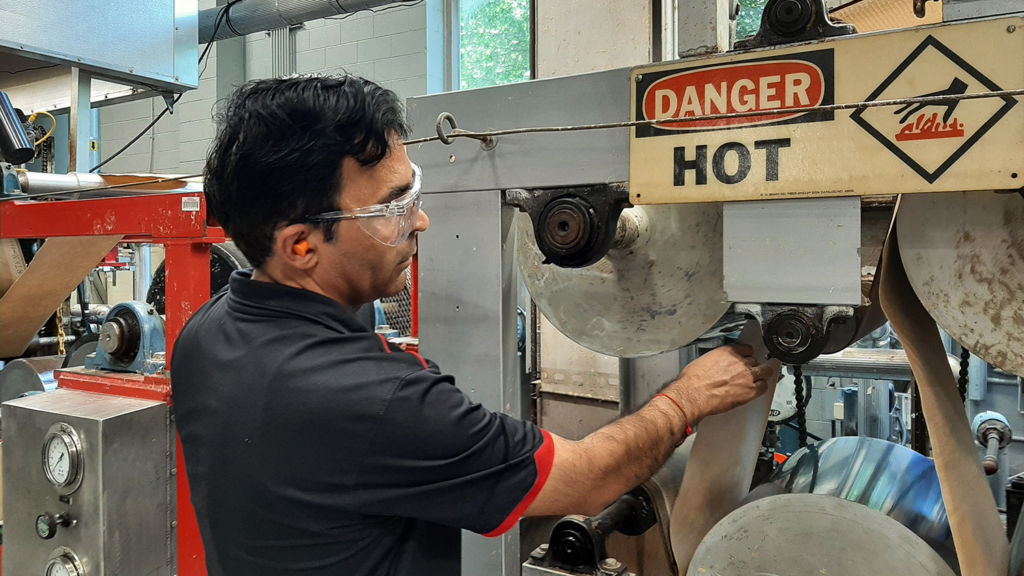NC State to Lead $10M Initiative to Decarbonize Forest Products Industry
NC State to Lead $10M Initiative to Decarbonize Forest Products ... NC State College of Natural Resources News


A $10 Million Initiative to Reduce Greenhouse Gas Emissions in the Forest Products Industry
A group of researchers from the NC State Department of Forest Biomaterials has been selected to lead a $10 million, public-private research initiative aimed at reducing greenhouse gas emissions in the forest products industry.
The Clean Energy Manufacturing Innovation Institute: EPIXC
Funded by the U.S. Department of Energy, the initiative belongs to the Clean Energy Manufacturing Innovation Institute known as EPIXC, or Electrified Processes for Industry Without Carbon.
Addressing Emissions in Six Industrial Sectors
EPIXC is a multi-institutional effort devoted to supporting the expanded use of clean electricity for process heating — the use of thermal energy to prepare materials for manufacturing — across a total of six industrial sectors. These sectors — iron and steel, chemicals, petroleum, food and beverage, forest products, and cement — account for more than 30% of emissions in the United States, largely as a result of fossil fuel-driven process heating.
Decarbonization Through Electrification and Energy Efficiency Improvements
“Our goal is to achieve decarbonization through electrification and by accelerating energy efficiency improvements,” said Lokendra Pal, the EJ Woody Rice Professor and a University Faculty Scholar in the Department of Forest Biomaterials at NC State.
Leading the Initiative
Pal is leading the initiative at NC State alongside Med Byrd, Ronalds Gonzalez, Hasan Jameel, Frederick Laleicke, Lucian Lucia, Sunkyu Park, and Richard Venditti, all professors in the Department of Forest Biomaterials.
Examining the Impact of Clean Electric Power Systems
The researchers plan to examine the impact of implementing clean electric power systems and efficient heating technologies on the carbon intensity of producing packaging products, tissue and hygiene products, and wood products.
NC State’s Unique Position for the Execution of the Project
“Our department is a global leader in research and educational excellence in manufacturing wood, pulp, paper, tissue and hygiene, and packaging products,” Pal said. “Our pilot test beds and strong industry support make it a unique place for the execution of this project.”

Transitioning to Sustainable Heating Technologies
Many paper mills and sawmills across the United States utilize boilers to generate steam for the drying of paper and wood. Some of these boilers operate off the burning of fossil fuels such as coal and natural gas, a process that releases greenhouse gases into the atmosphere.
Pal and his colleagues will work to convert steam-based boilers into clean electric power systems, offering a more sustainable source of heating which doesn’t produce as many emissions whilst improving efficiency.
Meanwhile, they will also study the impact of utilizing plasma-based technologies and ultrasonic- and microwave-assisted heating systems to further promote the sustainable production of paper and wood products.
Collaboration with Universities, Federal Agencies, and Industry Partners
Pal and his NC State colleagues will work alongside researchers from a variety of universities and federal agencies as part of the five-year initiative. They will also recruit the assistance of industry partners to raise additional funding and to support the development and deployment processes.
“To achieve the decarbonization of the industrial sector, it’s crucial that we foster and nurture collaboration across the public-private spectrum,” Pal said. “These partnerships bridge the gap between research and commercialization.”
EPIXC and Manufacturing USA
EPIXC is one of two Manufacturing USA Institutes involving researchers from the Department of Forest Biomaterials at NC State. Established in 2014, Manufacturing USA is a nationwide network of public-private partnerships that convenes business competitors, academic institutions, and other stakeholders to help the United States secure global leadership in advanced manufacturing.
Key partners include Arizona State University, University of Texas at Austin, Missouri University of Science and Technology, Navajo Technical University, Pennsylvania State University, Stanford University, Texas A&M University, Tuskegee University, Idaho National Laboratory, National Renewable Energy Laboratory, National Energy Technology Laboratory, among others.
SDGs, Targets, and Indicators
1. Which SDGs are addressed or connected to the issues highlighted in the article?
- SDG 7: Affordable and Clean Energy
- SDG 9: Industry, Innovation, and Infrastructure
- SDG 13: Climate Action
- SDG 17: Partnerships for the Goals
The article discusses a research initiative aimed at reducing greenhouse gas emissions in the forest products industry through the use of clean electricity and energy efficiency improvements. This aligns with SDG 7, which focuses on ensuring access to affordable, reliable, sustainable, and modern energy for all. It also relates to SDG 9, which promotes sustainable industrialization and innovation. Additionally, the initiative contributes to SDG 13 by addressing climate change through decarbonization efforts. Finally, SDG 17 is relevant as it emphasizes the importance of partnerships and collaboration to achieve sustainable development goals.
2. What specific targets under those SDGs can be identified based on the article’s content?
- SDG 7.2: Increase the share of renewable energy in the global energy mix
- SDG 9.4: Upgrade infrastructure and retrofit industries to make them sustainable
- SDG 13.2: Integrate climate change measures into national policies, strategies, and planning
- SDG 17.16: Enhance the global partnership for sustainable development
The article highlights the goal of achieving decarbonization through electrification and energy efficiency improvements in the forest products industry. This aligns with SDG 7.2, which aims to increase the share of renewable energy in the global energy mix. The initiative also involves upgrading infrastructure and retrofitting industries to make them more sustainable, which corresponds to SDG 9.4. Furthermore, integrating climate change measures into national policies and strategies is a target under SDG 13.2, which is relevant to the article’s focus on reducing greenhouse gas emissions. Lastly, the collaboration between researchers, universities, federal agencies, and industry partners reflects the aim of enhancing the global partnership for sustainable development, as stated in SDG 17.16.
3. Are there any indicators mentioned or implied in the article that can be used to measure progress towards the identified targets?
- Percentage of renewable energy in the forest products industry
- Reduction in greenhouse gas emissions from the forest products industry
- Number of infrastructure upgrades and retrofits in the forest products industry
- Integration of climate change measures in national policies and strategies
- Number of partnerships and collaborations established for sustainable development
The article does not explicitly mention specific indicators. However, progress towards the identified targets can be measured using indicators such as the percentage of renewable energy in the forest products industry, the reduction in greenhouse gas emissions from the industry, the number of infrastructure upgrades and retrofits implemented, the extent of integration of climate change measures in national policies and strategies, and the number of partnerships and collaborations established for sustainable development.
SDGs, Targets, and Indicators
| SDGs | Targets | Indicators |
|---|---|---|
| SDG 7: Affordable and Clean Energy | 7.2: Increase the share of renewable energy in the global energy mix | – Percentage of renewable energy in the forest products industry |
| SDG 9: Industry, Innovation, and Infrastructure | 9.4: Upgrade infrastructure and retrofit industries to make them sustainable | – Number of infrastructure upgrades and retrofits in the forest products industry |
| SDG 13: Climate Action | 13.2: Integrate climate change measures into national policies, strategies, and planning | – Integration of climate change measures in national policies and strategies |
| SDG 17: Partnerships for the Goals | 17.16: Enhance the global partnership for sustainable development | – Number of partnerships and collaborations established for sustainable development |
Behold! This splendid article springs forth from the wellspring of knowledge, shaped by a wondrous proprietary AI technology that delved into a vast ocean of data, illuminating the path towards the Sustainable Development Goals. Remember that all rights are reserved by SDG Investors LLC, empowering us to champion progress together.
Source: cnr.ncsu.edu

Join us, as fellow seekers of change, on a transformative journey at https://sdgtalks.ai/welcome, where you can become a member and actively contribute to shaping a brighter future.







